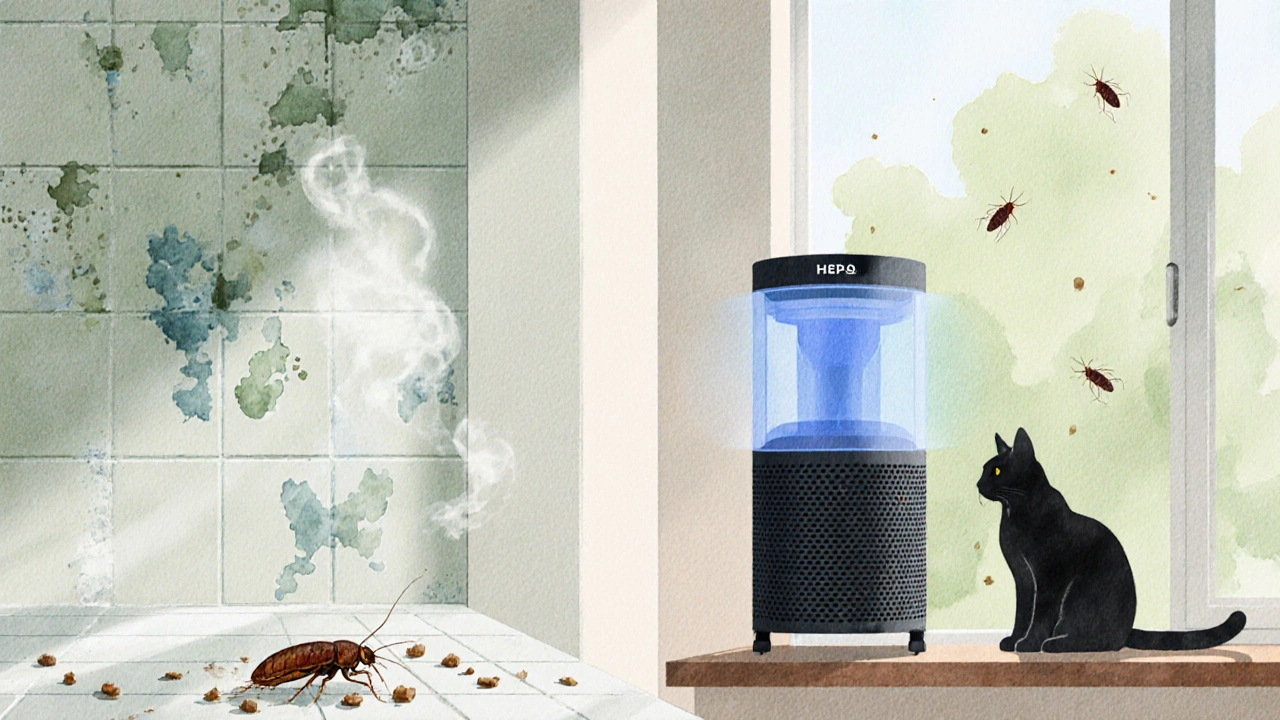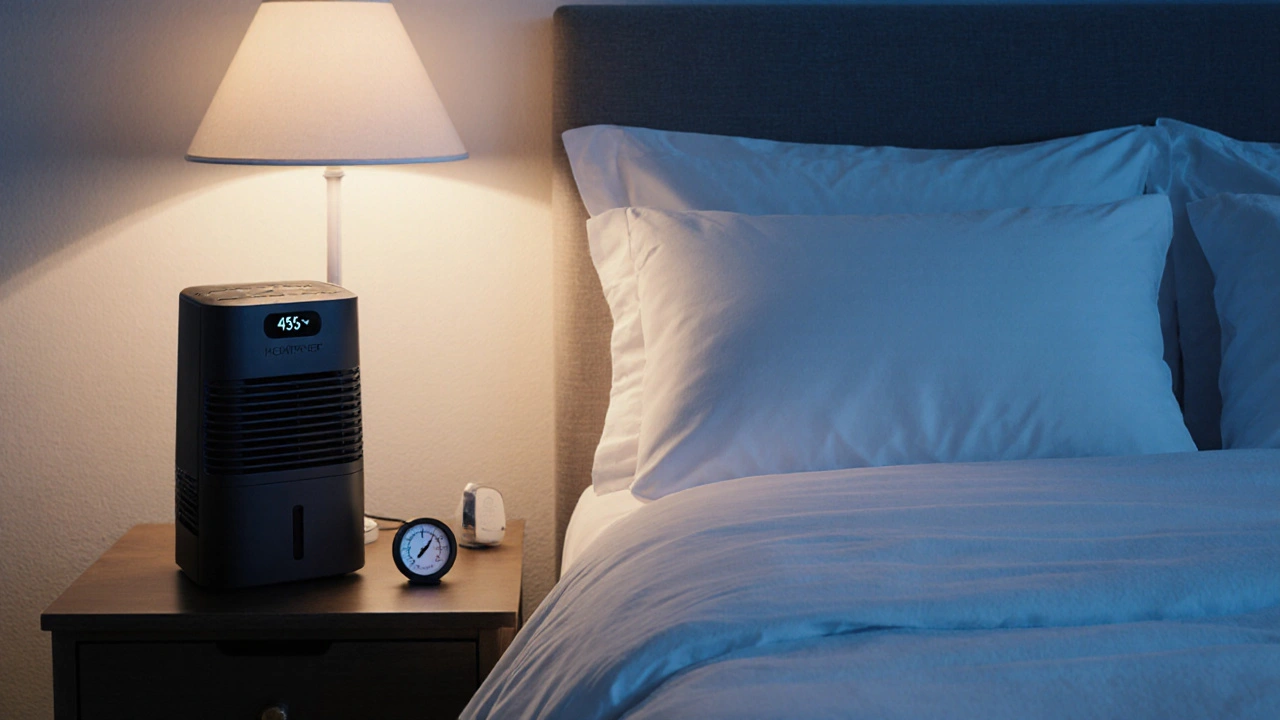Year-Round Allergy Trigger Identifier
Select one or more triggers below to learn more about each one and how to manage them effectively.
Dust Mites
Microscopic arthropods thriving in warm, humid bedding and furniture.
Mold Spores
Fungal particles spreading in damp indoor environments.
Pet Dander
Tiny flakes of skin shed by cats, dogs, and other furry animals.
Cockroach Allergen
Proteins found in cockroach saliva, feces, and body parts.
Pollen
Fine powder produced by flowering plants for reproduction.
Air Pollution
Particulate matter and gases that irritate the airways.
Chemical Irritants
Volatile organic compounds found in cleaning agents and fragrances.
Food Allergens
Protein fragments in foods that can trigger systemic allergic reactions.
Temperature Swings
Rapid changes in indoor temperature that dry out mucous membranes.
Quick Takeaways
- Allergens aren’t just a spring problem - dust mites, mold, and pets can keep you sneezing all year.
- Knowing the source of each trigger helps you cut exposure dramatically.
- Simple home‑maintenance steps (de‑humidify, HEPA filter, regular cleaning) work for most indoor culprits.
- Outdoor triggers like pollen still matter in off‑season months thanks to climate‑driven pollen spikes.
- If symptoms persist despite control measures, it’s time to talk to a health‑care professional.
Allergy season feels endless for many people. While most of us picture blooming trees and a brief spring burst, millions suffer from year-round allergies that keep the nasal passages inflamed 12 months a year. The culprit? A mixture of outdoor and indoor allergens that never truly go away. This guide breaks down the ten most common triggers, shows why they stick around, and gives practical steps you can take today to breathe easier.
What Makes an Allergy Tick All Year?
At its core, an Allergy is an immune system overreaction to otherwise harmless substances called allergens. When your body meets an allergen, it releases histamine, leading to itchy eyes, runny nose, and that dreaded post‑nasal drip. For most people, exposure spikes in specific seasons - pollen in spring, ragweed in fall. But some allergens linger indoors, and climate change is extending outdoor pollen seasons, turning a seasonal nuisance into a year‑long battle.

The Top 10 Year‑Round Allergy Triggers
-
Dust mites are microscopic arthropods that thrive in warm, humid bedding, upholstered furniture, and carpets
They feed on dead skin cells and release proteins that are potent allergens. Because they live inside your home, they’re hard to avoid unless you control humidity and clean regularly.
Mitigation: Use allergen‑proof mattress and pillow covers, wash bedding in ≥60°C weekly, and keep indoor humidity below 50% with a de‑humidifier.
-
Mold spores are fungal particles that spread through damp indoor environments, especially bathrooms, basements, and leaky roofs
Mold thrives on any moisture, releasing spores that irritate the respiratory tract. It’s a common problem in humid climates like Sydney.
Mitigation: Fix leaks promptly, improve ventilation, and clean visible mold with a diluted bleach solution.
-
Pet dander is tiny, lightweight flakes of skin shed by cats, dogs, and other furry animals
Unlike fur, dander can stay airborne for weeks, lodging in furniture and HVAC systems.
Mitigation: Bathe pets weekly, keep them out of bedrooms, and run a HEPA air purifier.
-
Cockroach allergen is proteins found in cockroach saliva, feces, and body parts that can become airborne
Urban dwellings with food crumbs or clutter provide perfect habitats, and the allergen can trigger asthma and nasal symptoms.
Mitigation: Eliminate food debris, seal entry points, and consider professional pest control.
-
Pollen is the fine powder produced by flowering plants, grasses, and trees for reproduction
Even in winter, indoor plants, window pollen drift, and climate‑shifts can keep pollen levels high.
Mitigation: Keep windows closed on high‑pollen days, use air filtration, and wash clothes after outdoor activities.
-
Air pollution refers to particulate matter (PM2.5, PM10) and gases like ozone that irritate the airways
Smog and vehicle emissions can worsen allergic inflammation, especially in dense urban areas.
Mitigation: Monitor AQI, limit outdoor exertion on polluted days, and use indoor air purifiers.
-
Chemical irritants are volatile organic compounds (VOCs) found in cleaning agents, paints, and fragrances
These substances can provoke similar symptoms to allergens, aggravating the same pathways.
Mitigation: Opt for fragrance‑free, low‑VOC products and ventilate rooms while cleaning.
-
Food allergens are protein fragments in foods like nuts, shellfish, and dairy that can trigger systemic allergic reactions
While typically associated with immediate reactions, chronic exposure can keep the immune system on high alert, worsening respiratory symptoms.
Mitigation: Identify trigger foods via testing, read labels, and keep a food diary.
-
Seasonal temperature swings
Rapid changes in indoor temperature (e.g., heating in winter, air‑conditioning in summer) can dry out mucous membranes, making them more susceptible to allergens.
Mitigation: Use a humidifier in winter, keep indoor temperature stable, and stay hydrated.
Quick Reference Table
| Trigger | Typical Source | Indoor / Outdoor | Easy Mitigation |
|---|---|---|---|
| Dust mites | Bedding, carpets, upholstered furniture | Indoor | Allergen‑proof covers, wash at 60°C, de‑humidify |
| Mold spores | Damp walls, bathrooms, basements | Indoor | Fix leaks, improve ventilation, clean with bleach |
| Pet dander | Cats, dogs, other furry pets | Indoor | Regular grooming, keep pets out of bedroom, HEPA filter |
| Cockroach allergen | Crumbs, clutter, warm corners | Indoor | Seal cracks, eliminate food residue, pest control |
| Pollen | Trees, grasses, indoor plants | Both | Close windows, use air filter, wash clothes after outdoors |
| Air pollution | Vehicle exhaust, industrial smog | Outdoor (affects indoor air) | Check AQI, limit outdoor activity, use indoor purifier |
| Chemical irritants | Cleaning agents, paints, fragrances | Indoor | Choose low‑VOC, fragrance‑free products, ventilate |
| Food allergens | Nuts, shellfish, dairy, etc. | Both (ingested) | Identify triggers, read labels, keep a diary |
| Temperature swings | Heating, air‑conditioning cycles | Indoor | Use humidifier, maintain stable thermostat |

Managing Triggers: A Practical Action Plan
Knowing the culprits is half the battle. The next step is turning that knowledge into daily habits.
- Daily cleaning sweep: Vacuum with a HEPA‑equipped machine, dust surfaces with a damp cloth, and mop floors with hot water.
- Seasonal deep‑clean: In spring and autumn, wash curtains, clean HVAC filters, and inspect for hidden mold.
- Air quality check: Invest in a low‑cost indoor air quality monitor; aim for PM2.5 < 12µg/m³.
- Allergy‑friendly bedding: Swap out feather pillows for synthetic, and replace old mattresses every 8‑10 years.
- Medical backup: Keep antihistamines or nasal corticosteroid sprays on hand, but use them under guidance.
When to Call a Professional
If you experience any of the following, it’s time to see an allergist or ENT specialist:
- Symptoms persisting despite rigorous trigger control for more than two weeks.
- Sleep disruption, daytime fatigue, or reduced work performance.
- Worsening asthma attacks or need for rescue inhalers.
- Development of sinus infections, ear pain, or chronic cough.
A specialist can perform skin‑prick testing or specific IgE blood tests to pinpoint exact allergens, and may recommend immunotherapy (allergy shots or sublingual tablets) for long‑term relief.
Frequently Asked Questions
Can I be allergic to more than one trigger at the same time?
Absolutely. Many people have multi‑sensitivities - for example, dust mites and pet dander together can create a compounded effect that feels worse than either alone.
Why do my allergy symptoms get worse in winter?
Winter heating dries indoor air, which irritates nasal passages, and people spend more time indoors where dust mites, mold, and pet dander accumulate.
Is a HEPA filter worth the investment?
Yes. HEPA filters capture particles as small as 0.3µm, including pollen, dust‑mite debris, and mold spores, dramatically lowering airborne allergen load.
Can allergy shots cure my year‑round allergies?
Immunotherapy doesn’t ‘cure’ allergies, but it retrains the immune system, often leading to a 60‑80% reduction in symptoms after 3‑5 years of treatment.
How often should I replace my HVAC filter?
At minimum every 90days, but in high‑allergy seasons or if you have pets, change it every 30‑45days.


Taryn Esses
October 10, 2025 AT 22:16I never realized dust mites could be such a hidden problem.
Matt Quirie
October 18, 2025 AT 13:36While the article offers a solid overview of year‑round allergens, it could benefit from more precise references, especially regarding humidity thresholds; additionally, the mitigation list would be stronger if it cited specific product standards, such as HEPA filter ratings, or provided links to reputable sources.
Pat Davis
October 26, 2025 AT 04:56The guide correctly emphasizes indoor triggers, but it understates the impact of combined exposures; when dust mites, pet dander, and mold coexist, the immune response can amplify dramatically, so a holistic strategy is essential.
Mary Wrobel
November 2, 2025 AT 20:16Wow, those dust mites are like tiny ninjas sneaking into your sheets, and the mold spores are basically nature’s confetti that just loves to crash your party. Love the practical tips – a good HEPA filter and a de‑humidifier can turn your home from an allergen jungle into a sanctuary.
Lauren Ulm
November 10, 2025 AT 11:36Reading this feels like they’re hiding the fact that big corporations add hidden chemicals to cleaning sprays 🤔🚨; those VOCs can act like invisible allergens, making the whole “clean house” myth a bit of a scam.
Michael Mendelson
November 18, 2025 AT 02:56Indeed, the endeavor to combat perennial allergens demands an unwavering commitment, and one must not fall prey to the complacency that pervades modern domesticity. First and foremost, the very notion of “simple cleaning” is a gross simplification; true mitigation begins with an audit of one’s living environment, a meticulous inventory of humidity levels, and a systematic eradication of micro‑habitats where arthropods flourish.
Take dust mites, for example – they are not merely passive occupants of bedding; they are prolific breeders that can proliferate to alarming densities when relative humidity exceeds the critical threshold of fifty percent. Thus, employing a high‑capacity de‑humidifier, paired with allergen‑impermeable encasements, constitutes a non‑negotiable baseline.
Second, when addressing mold, one must adopt a dual‑pronged approach: chemical remediation using a properly diluted sodium hypochlorite solution, and structural remediation to eliminate sources of condensation, such as leaky ducts or inadequate ventilation in basements.
Third, pet dander mitigation is often dismissed as a minor inconvenience, yet the literature underscores its capacity to exacerbate asthmatic responses, especially when combined with airborne particulates. Regular grooming, strategic bedroom exclusions, and the strategic placement of HEPA filtration units can dramatically attenuate exposure.
Moreover, the article’s omission of the socio‑economic dimensions of allergy management is a glaring oversight. Access to premium air purifiers, professional pest control, and specialized bedding is not universal, thereby perpetuating health disparities.
Finally, one should not underestimate the psycho‑physiological feedback loop wherein chronic irritation begets heightened stress, which in turn amplifies inflammatory pathways. Mind‑body interventions, such as guided respiration and stress‑reduction techniques, may serve as valuable adjuncts to the physical measures outlined.
In sum, a comprehensive, layered strategy-encompassing environmental control, socioeconomic awareness, and holistic well‑being-represents the only viable pathway to truly mastering year‑round allergen exposure.
Just Sarah
November 25, 2025 AT 18:16While the recommendations are thorough, one might consider citing peer‑reviewed studies, ensuring each mitigation step is evidence‑based; this would strengthen the credibility of the guide, and provide readers with avenues for further investigation.
Anthony Cannon
December 3, 2025 AT 09:36Keep your HVAC filter clean; it helps.
Kristie Barnes
December 11, 2025 AT 00:56That tip really helped me.